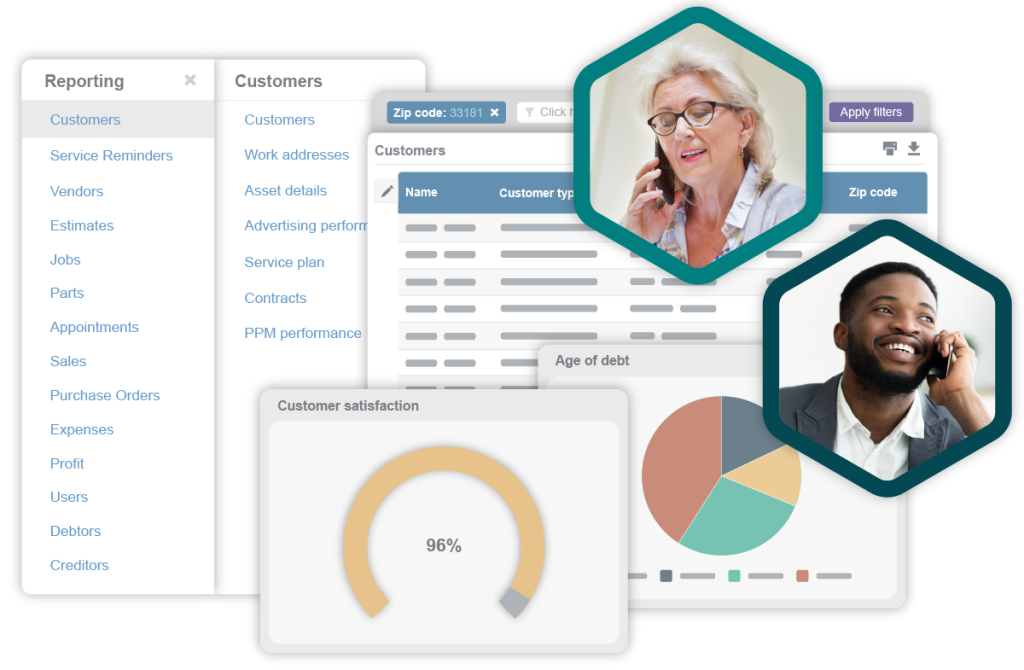17 Field Service Metrics that Enable Business Growth
August 9, 2023 | Read: 14 minutes

These metrics provide valuable insights into the efficiency, effectiveness, and overall quality of operations.
By tracking and analyzing specific metrics, businesses can identify areas for improvement, optimize processes, and increase customer service ratings.
What Are Field Service Metrics?
Field service metrics are key performance indicators (KPIs) used to evaluate how well a company is at delivering services to its customers.
They’re crucial for success because they enable companies to measure their performance against set targets and industry benchmarks.
They help identify trends, patterns, and potential issues that might be affecting service delivery.
Additionally, these metrics allow for data-driven decision-making that empowers businesses to make strategic changes that drive growth and success.

Why Metrics Matter for Business Growth in the Field Service Industry
If you’re not currently keeping track of field service metrics, you’ll be unable to find new ways to expand your field service business. Key performance indicators directly impact a company’s growth in three important ways:
- Field service KPIs help to optimize service operations, guaranteeing that field technicians are working at maximum efficiency while staying within guidelines. This efficiency translates into quicker response times and more service appointments each day, leading to increased customer loyalty and revenue.
- Key metrics like First-Time Fix Rate (FTFR) and Mean Time to Repair (MTTR) significantly reduce customer downtime. When you have the ability to analyze and track important metrics like these, you can learn and teach technicians how to advance their careers. It also enhances the overall customer experience and strengthens the company’s reputation, leading to an expanded client base and revenue growth.
- By tracking operational metrics, field service companies can identify inefficiencies in their processes and make changes that enrich service delivery but reduces operational costs. This frees up space in the budget that can be used to improve other aspects of the business.
Key Performance Indicators (KPIs) for Field Service Success
- Service Delivery Metrics: focuses on the productivity of field technicians when delivering services to customers.
- Customer Satisfaction Metrics: assess how well the company meets customer expectations and provides a positive service experience.
- Operational Efficiency Metrics: evaluates the effectiveness and success of the entire field service operation.
Service Delivery Metrics
1. First-Time Fix Rate (FTFR)
The First-Time Fix Rate (FTFR) measures the percentage of service appointments in which the issue is resolved on the first visit by a field technician. A high FTFR indicates efficient and skilled technicians, as well as a prepared service approach.
Calculation: FTFR = (Number of First-Time Fixes / Total Number of Service Appointments) * 100
A higher FTFR signifies high-quality service, reduced customer inconvenience, and results in happy clients that leave better reviews.
To improve first-time fix rates, companies should invest in comprehensive technician training and make sure technicians always have access to the right tools and parts. You should also be providing them with detailed service history and customer information before arriving at the appointment (which is automatically stored and accessible when using the right field service software)

2. Mean Time to Repair (MTTR)
The Mean Time to Repair (MTTR) measures the average time it takes to repair a customer’s equipment or resolve a service issue. A lower MTTR indicates quicker problem resolution and a higher quality of service from technicians.
Calculation: MTTR = (Total Time Taken to Repair / Number of Service Requests)
A lower MTTR indicates faster problem resolution, minimizing customer downtime and improving the overall service experience. If you’re struggling to lower this number, talk to your technicians to see if they’re missing any tools, technologies, or need additional training to help expand their knowledge and speed up on-the-job processes.
Reducing MTTR increases field technician productivity, enables more work orders to be completed each day, and creates a positive reputation for the company.
3. Mean Time Between Failures (MTBF)
Mean Time Between Failures (MTBF) measures the average time between failures of a piece of equipment or system. A higher MTBF indicates strong reliability and performance of the equipment.
Calculation: MTBF = (Total Uptime of Equipment / Number of Failures)
A higher MTBF suggests that the equipment is more reliable, reducing the frequency of service requests and stress on staff while lowering maintenance costs.
To raise the MTBF, companies should focus on regular preventive maintenance, using high-quality components, and monitoring equipment performance for early detection of potential issues.
4. Service Level Agreement (SLA) Compliance
Service Level Agreement (SLA) Compliance measures the percentage of requests that meet the agreed-upon SLA response and resolution times. It reflects the company’s ability to meet customer expectations and contractual commitments.
Calculation: SLA Compliance = (Number of SLA-Compliant Service Requests / Total Number of Service Requests) * 100
Meeting SLAs is crucial for maintaining customer trust, satisfaction, and contractual compliance, all of which contribute to customer loyalty and business growth. Depending on the contract, breaching a service level agreement can be costly and hurt the reputation of a company.
To always stay compliant, businesses should set realistic SLA targets, optimize scheduling processes, and proactively communicate with customers regarding service timelines.
5. On-Time Arrival Percentage
While this may seem simple, it’s a very important service delivery metric. On-Time Arrival Percentage measures the percentage of service appointments where the field technician arrived at the scheduled time.
Calculation: On-Time Arrival Percentage = (Number of On-Time Arrivals / Total Number of Appointments) * 100
A higher on-time arrival percentage reflects the company’s commitment to respecting customer schedules and expectations. To improve on-time arrival, optimize scheduling and routing, provide technicians with real-time traffic updates, and maintain communication with customers regarding appointment timings.
By tracking and optimizing these service delivery metrics, businesses can overhaul their field service operations and create processes that lead to sustainable business growth.
Customer Satisfaction Metrics
Customer satisfaction metrics play a vital role in understanding how well a company is meeting its customers’ wants, needs, and expectations. These metrics provide insights into the overall satisfaction levels of customers, helping businesses identify new ways they can improve the customer experience and grow the client base. Here are some essential customer satisfaction metrics:
6. Net Promoter Score (NPS)
Net Promoter Score (NPS) is a widely used metric to determine customer loyalty and is a quick way to get valuable feedback. It measures the likelihood of a customer recommending a company’s products or services to others.
NPS is based on the familiar question: “On a scale of 0 to 10, how likely are you to recommend our company to somebody you know?”
Calculation: NPS is calculated by categorizing respondents into three groups:
- Promoters (score 9-10): Customers who are highly satisfied and likely to promote the company.
- Passives (score 7-8): Customers who are satisfied but not as quick to recommend the company.
- Detractors (score 0-6): Customers who are dissatisfied and may even spread negative word-of-mouth.
NPS is then calculated as follows: NPS = % Promoters – % Detractors and expressed using a score ranging from -100 to 100.
If the number of detractors is greater than promoters, the score will be below 0. Keep in mind that the average score can change widely depending on the industry and no business will have a perfect score.
This KPI provides valuable info into customer devotion and brand advocacy. A higher NPS indicates a strong customer base that is likely to recommend the company, which can lead to organic growth through word-of-mouth or online referrals.
To increase the net promoter score, field service organizations should focus on addressing issues outlined by detractors, actively engaging with promoters for testimonials, and be continuously working to perfect the customer experience from start to finish.
7. Customer Retention Rate
Customer Retention Rate measures the percentage of customers that a company retains over a specific period. A high customer retention rate indicates satisfied and happy customers who will continue to use the services and products offered.
Calculation: Customer Retention Rate = ((Number of Customers at the End of a Period – Number of New Customers Acquired During the Period) / Number of Customers at the Start of the Period) * 100
Having a strong customer retention rate is crucial for long-term business success since it costs significantly less to retain existing customers than to acquire new ones. On top of that, the most consistent customers tend to spend more and have a great chance to provide repeat business.
To improve customer retention, companies should focus on delivering exceptional customer service, offering personalized experiences, and implementing loyalty programs to reward and incentivize clients.
8. Customer Acquisition Cost (CAC)
Customer Acquisition Cost (CAC) measures the average cost incurred to acquire a new customer. This metric helps businesses understand the effectiveness of their marketing and sales efforts in attracting and converting new customers.
Calculation: Customer Acquisition Cost = (Total Marketing and Sales Expenses) / (Number of New Customers Acquired)
Understanding CAC is essential for maintaining a healthy business model. If the cost of acquiring new customers is too high, it can impact profitability and hinder growth.
To reduce CAC, companies can optimize their marketing channels and campaigns, target the right audience, and focus on encouraging them to come back with different promotions.
9. Customer Effort Score (CES)
Customer Effort Score (CES) measures the ease of the customer’s experience when interacting with a company or resolving an issue. It seeks to understand how much effort a customer had to put forth to achieve their desired outcome.
Calculation: Customers are asked a question like: “On a scale of 1 to 10, how much effort did you have to give to get the issue at hand resolved?
A score of 1 indicates low effort, while a score of 7+ indicates high effort.
Averaging the scores lets you understand the friction points in the customer journey. Lower scores indicate a smoother and stress-free experience.
To lower customer effort scores, businesses should streamline workflows, provide self-service solutions, and ensure prompt support during customer interactions. Additionally, using customer feedback to identify pain points can reveal opportunities for improvement.
By tracking these customer satisfaction metrics, businesses can gain valuable insights into their customers’ needs and expectations. This information can be used to drive improvements in products, services, and processes – leading to increased customer loyalty, positive reviews, and profitable business growth.
Operational Efficiency Metrics
10. Average Resolution Time (ART) & Response Time
Average Resolution Time (ART) is the typical amount of time it takes for field technicians to resolve a work order or service request. While Reposone Time is the average amount of time it takes for the company to respond to any inquiry.
Calculation: ART = (Total Time Taken to Resolve Service Requests) / (Number of Service Requests)
Faster resolution and response times lead to reduced downtime for clients, ultimately enhancing the company’s reputation and customer loyalty.
To reduce average resolution time, businesses should invest in training technicians to handle a wider range of issues. You can also optimize scheduling to minimize travel time and provide technicians with access to real-time information and support.
11. Technician Utilization
Technician Utilization calculates the percentage of time that field techs spend on billable service work versus non-productive or downtime.
Calculation: Technician Utilization = ((Total Billable Hours Worked by Technicians) / (Total Hours Available for Work)) * 100
Higher technician utilization indicates efficient resource allocation and better cost-effectiveness throughout your field service operations.
To improve technician utilization, companies can implement automated scheduling and fleet management software, allocate tasks based on technicians’ skill sets, and leverage technology to streamline administrative tasks.
12. Number of Repeat Visits
The Number of Repeat Visits measures the amount of additional visits a field technician needs to make to fully resolve an issue that wasn’t fixed properly that first time.
Calculation: Number of Repeat Visits = (Total Number of Repeat Visits) / (Total Number of Service Appointments)
A high number of repeat visits indicates inefficiencies in the initial task or resolution, leading to increased operational costs, customer dissatisfaction, and potentially negative reviews.
To reduce repeat visits, businesses should focus on improving First-Time Fix Rate (FTFR), provide comprehensive training to technicians, ensure they have access to the necessary equipment and inventory, and implement effective quality control (QC) measures.
13. Average Cost, Travel Time, and Distance
The Average Cost is the median cost incurred per work order – including labor, parts, and travel expenses. Travel Time measures the average time spent by technicians traveling to service locations. Distance measures the average length traveled for service appointments.

Calculation:
- Average Cost = (Total Cost of Service Appointments) / (Total Number of Service Appointments)
- Travel Time: Total Travel Time / Total Number of Service Appointments Travel
- Distance: Total Distance / Total Number of Service Appointments
Tracking average cost, travel time, and distance helps businesses understand their daily operational expenses and creates opportunities for cost reduction and process optimization.
To lower average cost, travel time, and distance, businesses can optimize technician routes and adopt technologies like GPS tracking to ensure the most efficient travel paths.
14. Parts Used per Repair
The Parts Used per Repair is an important KPI that tracks the average number of components utilized to complete a job.
Calculation: Parts Used per Repair = (Total Number of Parts Used) / (Total Number of Service Requests)
Simply put, a higher number of parts used per repair can increase inventory costs and service times while negatively impacting customers.
To reduce parts used per repair, businesses can implement better field service inventory management practices, conduct regular audits to identify overstocked parts, and provide technicians with the required info to diagnose and fix issues accurately.
15. Contract and Revenue Leakage
Contract and Revenue Leakage refers to the loss of potential profits due to issues such as undercharging, missed invoicing opportunities, or non-compliance with contractual terms.
Calculation: Contract and Revenue Leakage = (Potential Revenue – Actual Revenue) / Potential Revenue
Identifying and addressing contract and revenue leakage helps businesses maximize their revenue potential and confirms that service contracts are fully honored.
To reduce contract and revenue leakage, companies should implement software systems, conduct regular audits to ensure compliance, or improve data entry and billing accuracy.
16. Job and Service Profitability
Job and Service Profitability measures the profitability of each individual service appointment or job.
Calculation: Job and Service Profitability = (Total Revenue – Total Cost) / Total Revenue
Understanding job and service profitability helps businesses identify which services are the most lucrative and which may need adjustments to improve their financial performance.
To achieve higher job and service profitability, businesses can focus on new pricing strategies, reducing operational costs, and identifying cross-selling or upselling opportunities.
17. Time on Task
Time on Task measures the actual time field technicians spend on performing billable tasks or services.
Calculation: Time on Task = (Total Billable Hours Worked by Technicians) / (Total Number of Service Appointments)
Tracking time on task helps identify technician productivity and ensures accurate billing for services provided.
To improve time on task, businesses should optimize routing and scheduling, reduce administrative tasks, and streamline processes to minimize idle time throughout the day.
Choosing the Right Metrics for Your Business
Selecting the appropriate metrics is critical to ensure that they align with your business goals and provide actionable insights.
Make sure the metrics you select are relevant, measurable, and consistent to always stay on top of the data that will help better your company.
If you are struggling to prioritize metrics, identify the KPIs that have the most significant impact on your business goals and focus on improving them first.
Start Leveraging Field Service Metrics for Business Growth Today
Field service metrics are powerful tools that enable businesses to optimize their services, enhance customer service, and drive growth.
By regularly tracking and analyzing these metrics, businesses can make data-driven decisions, identify areas for improvement, and implement targeted strategies to boost operational efficiency and customer loyalty.
With the right metrics in place, companies can drive sustainable growth and stay ahead of the competition in today’s competitive landscape.

Anthony Vattimo
Thanks for checking out the Commusoft blog - I’ve been helping business owners improve their strategies for a few years now, so I hope you were able to take something away from the content I’ve written. Feel free to continue exploring the blog - or reach out to us with any questions!








